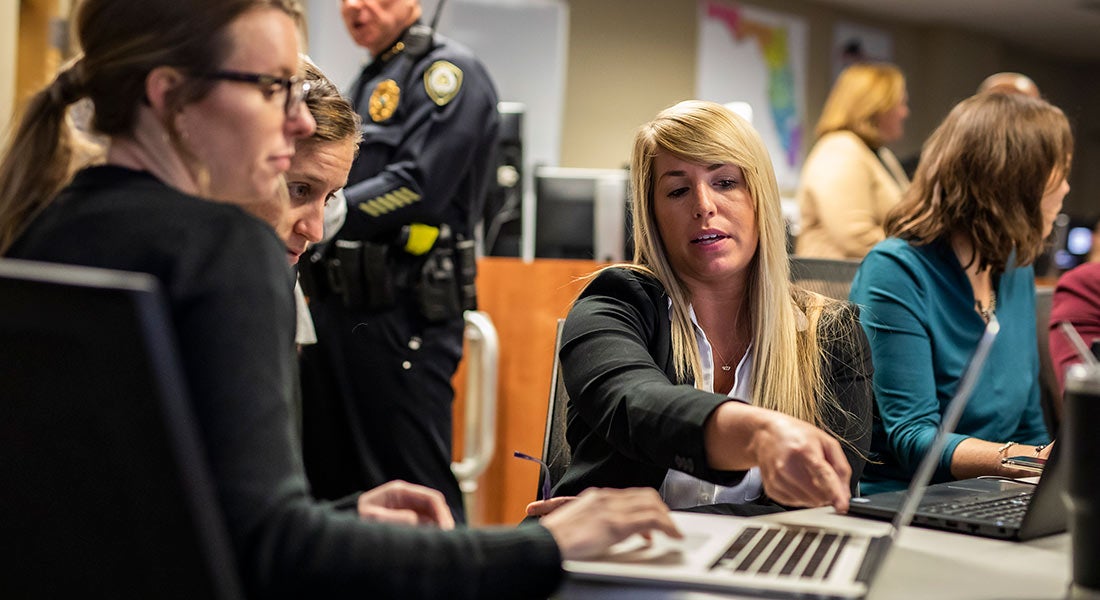One of the most sobering lessons of the COVID-19 pandemic is that disasters can befall any community, at any time. While infectious disease represents one form of disaster, it could just as readily be a hurricane, flood or chemical spill. According to the United Nations, a disaster is any event that seriously disrupts a community or society’s ability to function; a disaster’s impact may be human, economic or ecological.
Emergency management, also referred to as disaster management, means preparing for potential calamities and responding to them as quickly, strategically and effectively as possible. Typically, this involves following the basic disaster management cycle, which comprises five crucial stages.
Effective and ethical leadership during a disaster requires a number of essential skills. One of the best ways to hone them is through enrollment in an online leadership and management program, whether that means pursuing a full degree or a certificate program.
What is Disaster Management?
One of the biggest challenges of disaster, or emergency, management is the need to be prepared for a wide range of contingencies. A good place to begin a discussion of disaster management is by considering what constitutes a disaster.
Defining Disaster
According to the International Federation of Red Cross and Red Crescent Societies: “More people are becoming vulnerable to disasters or are forced to cope with acts of violence, financial crises and growing uncertainty, often without adequate support from their governments.” Disasters can be either natural or human-made events and can include pandemics, technological disasters or environmental cataclysms.
Disaster types include the following:
- Earthquakes
- Tornadoes
- Hurricanes
- Pandemics
- Volcano eruptions
- Wildfires
- Floods
- Mass shootings
- Acts of terror
- Nuclear explosions
- Chemical emergencies
There were 10 weather disasters each exceeding $1 billion in losses in the U.S. within the first half of 2020, according to the National Oceanic and Atmospheric Administration. The number of disasters resulting in billion-dollar loses has been steadily rising, from 29 disasters in the 1980s to 119 disasters in the 2010s. In addition to this increase, cascading disasters, such as a hurricane during the COVID-19 pandemic, reinforce the need for effective and ethical leadership across all sectors and levels of government.
Managing Disasters
Specifically, disaster management is about organizing and directing resources to cope with a disaster and coordinating the roles and responsibilities of responders, private sector organizations, public sector agencies, nonprofit and faith-based organizations, volunteers, donations, etc. The ultimate goal of the disaster-management leader is to minimize the event’s impact, something that involves preparedness, response, recovery and mitigation.
The 5 Stages of the Disaster-Management Cycle
When properly implemented, the disaster-management cycle can lessen the impact of a catastrophic event. It can also incorporate the policies and emergency responses needed for a full, expedited recovery. The cycle involves the following five stages:
1. Prevention
The best way to address a disaster is by being proactive. This means identifying potential hazards and devising safeguards to mitigate their impact. Although this stage in the cycle involves putting permanent measures into place that can help minimize disaster risk, it’s important to acknowledge that disasters can’t always be prevented.
Prevention involves scenarios such as the following:
- Implementing an evacuation plan in a school, for example, showing teachers how to lead students to safety in the event of a tornado or fire
- Planning and designing a city in a way that minimizes the risk of flooding, for example, with the use of locks, dams or channels to divert water away from populous areas
2. Mitigation
Mitigation aims to minimize the loss of human life that would result from a disaster. Both structural and nonstructural measures may be taken.
- A structural measure means changing the physical characteristics of a building or an environment to curb the effects of a disaster. For example, clearing trees away from a house can ensure that dangerous storms don’t knock down the trees and send them crashing into homes and public buildings.
- Nonstructural measures involve adopting or amending building codes to optimize safety for all future building construction.
3. Preparedness
Preparedness is an ongoing process in which individuals, communities, businesses and organizations can plan and train for what they’ll do in the event of a disaster. Preparedness is defined by ongoing training, evaluating and corrective action, ensuring the highest level of readiness.
Fire drills, active-shooter drills and evacuation rehearsals are all good examples of the preparedness stage.
4. Response
Response is what happens after the disaster occurs. It involves both short- and long-term responses.
Ideally, the disaster-management leader will coordinate the use of resources (including personnel, supplies and equipment) to help restore personal and environmental safety, as well as to minimize the risk of any additional property damage.
During the response stage, any ongoing hazards are removed from the area; for example, in the aftermath of a wildfire, any lingering fires will be put out, and areas that pose a high flammability risk will be stabilized.
5. Recovery
The fifth stage in the disaster-management cycle is recovery. This can take a long time, sometimes years or decades. For example, some areas in New Orleans have yet to fully recover from Hurricane Katrina in 2005. It involves stabilizing the area and restoring all essential community functions. Recovery requires prioritization: first, essential services like food, clean water, utilities, transportation and healthcare will be restored, with less-essential services being prioritized later.
Ultimately, this stage is about helping individuals, communities, businesses and organizations return to normal or a new normal depending on the impact of the disaster.
Developing Skills for Disaster Management
To effectively coordinate this cycle, disaster-management leaders must develop a number of critical skills. The skills necessary for each stage of the cycle are as follows:
Prevention
During the prevention stage, strong analytical skills help leaders identify potential threats, hazards and high-risk areas. Problem-solving abilities are also invaluable in identifying the best ways to avoid or diminish the likelihood of catastrophic events.
Mitigation
Planning is an important skill during the mitigation stage; the disaster-management leader will need to develop strategies and structural changes that can help mediate potential threats. Spreading awareness is also critical, as community members must be made aware of the steps they can take to prepare for all contingencies.
“Of the five stages, mitigation is the most crucial because, if done correctly, it can reduce the impact of the next emergency or crisis,” explains Claire Connolly Knox, associate professor and emergency and crisis management academic program coordinator at the University of Central Florida. “As per the National Institute of Building Science, for every $1 spent on mitigation, there is a $6 savings post-disaster. Mitigation can include changes to building codes as seen following Hurricane Andrew in 1992 or reinforcing infrastructure as seen in coastal communities…”
Preparedness
During the preparedness stage, it’s important to be skilled in training people to respond to disasters. It’s important to stay organized, which is the best way to ensure readiness. Oral and written communication skills prepare laypeople and emergency-response personnel for action in worst-case scenarios.
Response
The ability to quickly make decisions is crucial here, as the response stage is time-sensitive. Another valuable skill is delegating essential tasks to other volunteers or emergency responders.
Recovery
As disaster-management leaders help their communities recover, the most essential skills are empathy, understanding and relationship building; indeed, without earning the trust of the community, any recovery efforts are likely to come up short.
Becoming a Leader in Disaster Management
Some leaders have more experience than others with handling disasters; ultimately, though, this is a field in which every business or community leader should hone their skills. Any organization or municipality can be hit with a disaster sooner or later, whether that’s something as minor as a temporary power outage or as threatening as a hurricane, earthquake, bomb threat or active shooter.
The COVID-19 pandemic has really brought this home, as many business owners have confronted the crisis at hand. To ensure the safety of customers as well as employees, business leaders have shifted to remote work environments, implemented new communication infrastructures, and embraced new standards of office hygiene and sanitization. While no business leader could have precisely predicted the effects of the coronavirus, those companies that had some disaster plan in place are likely a step or two ahead of others.
Those looking for a career solely focused on mastering the disaster-management cycle have many opportunities to do so; some examples of jobs in this field include crisis-management lead, disaster-assistance specialist and emergency-planning coordinator. These roles all call for various levels of responsibility in preparing a company or a city for cataclysmic events. To find work in any of these positions, as well as to sharpen all the skills needed for success, earning a master’s degree in emergency and crisis management can be a big step forward.
Learning More About Disaster Management
Through the University of Central Florida, students can engage in dynamic courses that help them feel fully prepared to prevent, mitigate and respond to major disasters, successfully limiting damage to property, the environment and people.
“Students in the undergraduate and graduate emergency management programs at UCF participate in real-world opportunities, which allows them to gain key skills and competencies needed for this complex and dynamic profession,” says Knox. “One example is a functional exercise in an emergency operations center in which students apply multiple concepts to managing a fictional disaster using the same equipment and software programs as emergency management staff.”
Ultimately, disaster management is all about preparedness, and formal training is the best way to achieve it. The UCF Online Master’s in Emergency and Crisis Management (MECM) program is designed to cultivate the robust leadership skills needed to lead a community or an organization through crisis and to help them rebuild in its aftermath.
For people who are passionate about a field that helps businesses and communities mitigate calamity, UCF’s online leadership and management degree and certificate programs can provide the first step toward a meaningful career. Reach out for more information about the programs.
Online Leadership and Management Degrees at UCF
- Career and Technical Education, BS
- Career and Workforce Education, MA
- College Teaching and Leadership Graduate Certificate
- Corrections Leadership Graduate Certificate
- Educational Leadership, MA
- Emergency and Crisis Management, MECM
- Engineering Management, MS
- Event Management Graduate Certificate
- Health Information Management, BS
- Health Services Administration, BS
- Hospitality Management, BS
- Industrial Engineering, MSIE
- Leadership BA/BS
- Local Director of Career & Technical Education
- Lodging and Restaurant Management, BS
- Master of Business Administration - Space MBA
- Master of Public Administration, MPA
- Nonprofit Management
- Nonprofit Management, MNM
- Online Destination Marketing and Management Graduate Certificate
- Police Leadership
- Project Engineering
- Public Management and Leadership




